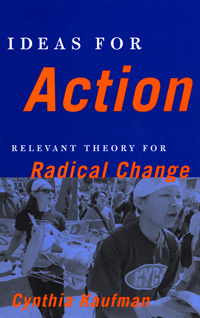 IDEAS FOR ACTION by Cynthia Kaufman BUY THIS BOOK |
After considering the long train of outrages committed by the current regime — an administration so callous, so degraded, that some European commentators have taken to calling George W. Bush a “gangsta bitch” (Dick Cheney is, of course, Bush’s “Original Gangsta”) — it’s nice to know that philosophy still has its consolations. That’s right, philosophy. When you’re flat on your back, a little dollop of philosophy may be just enough to get you up on one knee. One more dollop, and you’ll be balancing on your heels again.
In Ideas for Action, Cynthia Kaufman offers a bracing introduction to the complexities of leftist thought. Subtitled “Relevant Theory for Radical Change,” Kaufman’s study is a kind of philosophical Baedeker, a Rough Guide to the insights of Marxism, anarchism, feminism, and other isms of a reddish tint. It has the virtue of being easily read, a signal achievement in any work of social or political theory — so simple and lucid that one wonders why Kaufman’s fellow philosophers haven’t banned her from the academy for daring to write clearly.
Kaufman, a tenants rights activist who teaches philosophy at California’s De Anza College, doesn’t shy away from the big questions. She begins with “What Is Human Nature?” — right away you’ve got Adam Smith and Karl Marx going mano a mano, “enlightened self-interest” versus “human liberation” — and doesn’t stop until she’s touched on everything from direct democracy to deep ecology. Kaufman aims to reach an audience of young activists. You can easily imagine a tattooed Global Justice campaigner retrieving her book from his knapsack after a big demo, intent on revisiting some passage from Gramsci or Foucault: one more thickly underlined paragraph, one more swallow of espresso, then back to the Ruckus Society for more debate.
In a constantly recurring motif, Kaufman emphasizes the crucial role of the people in history — of the “ordinary people” acting collectively, with a conscious and disciplined will, to reform or radicalize society. She disparages the Great Man theory of history, which relegates the people to a passive, subservient role in historical events. This theory fits too neatly with a do-nothing defeatism for Kaufman’s taste. She wants to show her students and readers how progressive change has come from the power of the commons — from rank-and-file agitation, from democratic force. She cites the example of Rosa Parks, the NAACP activist who sparked the Montgomery bus boycott of 1956. And the example of Jeff Patterson, a young Marine who was the first serviceman to resist orders for deployment to the Persian Gulf in 1990. And, finally, the example of the De Anza College students whom she inspired to join “the battle of Seattle” in 1999 — the anti-globalization protests that the New Left Review called (perhaps too wishfully) “Five Days That Shook the World.”
Marx is certainly one of history’s Great Men — albeit one who fought unflinchingly for the commons — and he looms large in Kaufman’s pages. Marxism has many attractions, as the historian Eric Hobsbawm, a lifelong Communist, declares in his memoirs: compassion for the oppressed, “the aesthetic appeal of a perfect and comprehensive intellectual system,” and the “Blakean vision of a New Jerusalem” — not to mention something Hobsbawm calls “mass ecstasy.” Kaufman offers fascinating glimpses of Marx’s thought, ranging from his theory of class exploitation to his invocation of a classless utopia. She succeeds brilliantly in popularizing without vulgarizing.
Ideas for Action is a well-researched survey of radical thought, couched in a remarkably accessible style. One can only second the opinion of Roxanne Dunbar-Ortiz, another progressive professor: “This book is no monograph, rather a manual for organizers and the people. Kaufman’s modest yet sure voice is that of the best of feminist and social justice writing today.”
Dean Ferguson is an editor of Transformation, a newly launched literary journal. He lives and works in San Francisco.
|
| Print
